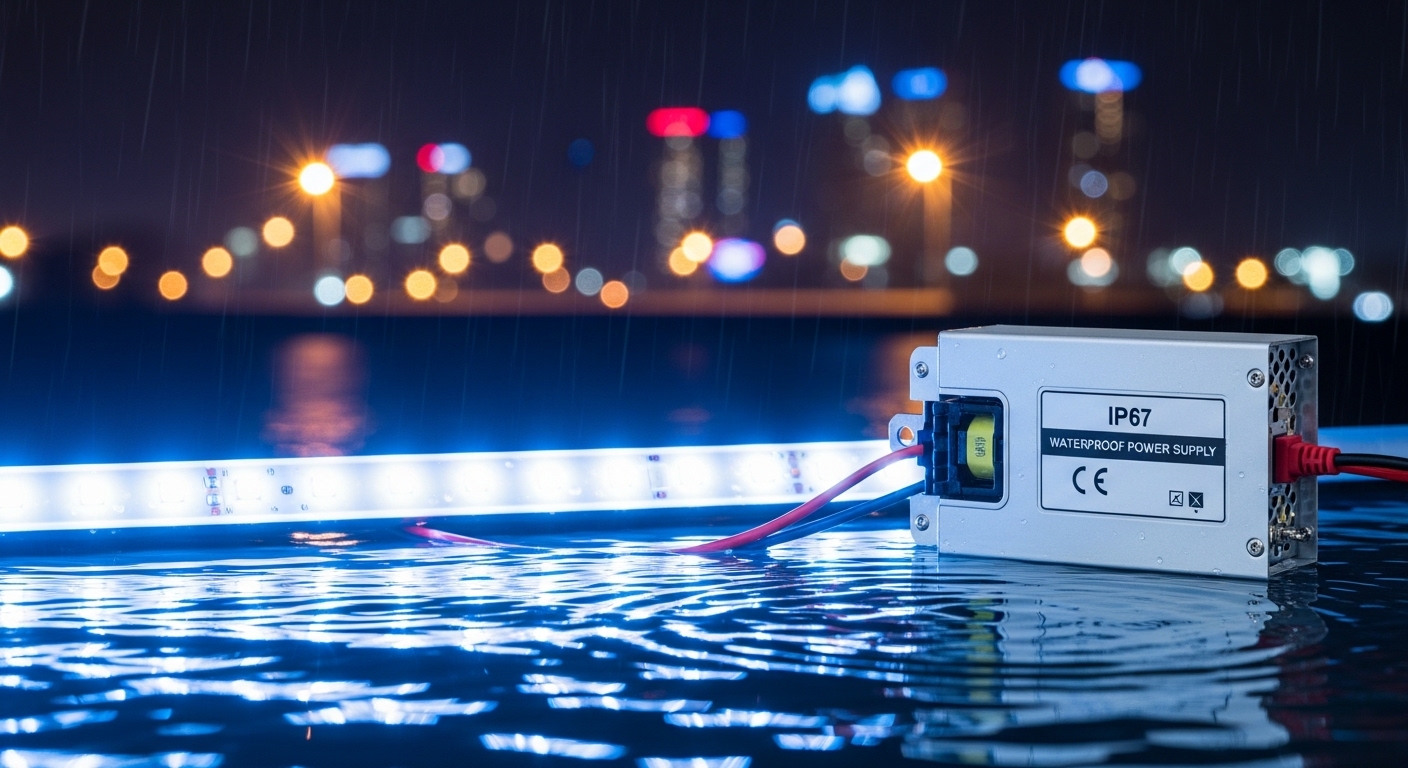GENERAL
The Essential Role of Waterproof Power Supply in Modern LED Lighting Systems

In the world of LED lighting, reliability is everything. Whether illuminating outdoor landscapes, architectural facades, or commercial interiors, every lighting project depends on one crucial component — the Waterproof Power Supply. Often overlooked by end users, this small but powerful device ensures that LED lighting systems operate safely and efficiently in any environment, from humid bathrooms to heavy rain outdoors.
For manufacturers, designers, and installers, understanding the importance of a high-quality Waterproof Power Supply is key to achieving performance, durability, and safety in every lighting installation.
1. What Is a Waterproof Power Supply?
A Waterproof Power Supply is an electronic device that converts high-voltage AC (alternating current) from the main grid into low-voltage DC (direct current), which is required to power LED lighting systems. What makes it “waterproof” is its robust design and sealed enclosure, typically rated with an IP (Ingress Protection) score such as IP65, IP67, or IP68.
- IP65 means it can resist dust and low-pressure water jets.
- IP67 can withstand temporary submersion in water.
- IP68 offers continuous underwater protection.
These protection levels ensure that even in wet or outdoor environments, the power supply remains stable and safe, preventing short circuits, corrosion, and system failures.
2. Why Waterproof Power Supply Is Crucial for LED Lighting
LED lighting systems — especially flexible LED strip lights and outdoor fixtures — require stable DC voltage to function properly. A poor-quality power supply can cause flickering, brightness inconsistency, or even permanent damage to LEDs.
A Waterproof Power Supply not only provides the necessary voltage conversion but also protects against environmental hazards such as rain, dust, and condensation. In architectural projects, garden lighting, or signage installations, it’s often exposed to extreme weather conditions, which makes waterproofing essential.
Moreover, in places like swimming pools, bathrooms, or kitchens, humidity can compromise electrical components. A sealed waterproof unit ensures long-term safety and reliability, making it a critical part of professional LED lighting systems.
3. Inside the Design of a Waterproof Power Supply
A high-quality Waterproof Power Supply combines advanced circuitry with durable materials. The enclosure is usually made of aluminum alloy or polycarbonate, offering both thermal conductivity and mechanical protection. Inside, high-efficiency transformers and capacitors regulate voltage output and maintain stability under varying loads.
Most models are filled with silicone gel or epoxy resin, which protects internal components from moisture and vibration while also improving heat dissipation. This design helps extend product lifespan, ensuring continuous operation even in harsh outdoor conditions.
Top manufacturers also integrate multiple protection mechanisms, including:
- Over-voltage protection
- Over-current protection
- Short-circuit protection
- Over-temperature protection
These safeguards make the power supply resilient and compliant with international safety standards such as CE, RoHS, UL, and FCC.
4. Applications of Waterproof Power Supplies
The use of Waterproof Power Supply extends across a wide range of industries and environments:
- Architectural Lighting: Powering LED strips, wall washers, and façade lights on building exteriors.
- Landscape Lighting: Supporting garden, pathway, and fountain illumination systems exposed to rain and humidity.
- Signage and Advertising: Providing stable voltage for outdoor billboards, channel letters, and neon replacements.
- Marine and Pool Lighting: Ensuring electrical safety in underwater and damp environments.
- Industrial Facilities: Supplying outdoor workstations, parking lots, and warehouses where exposure to dust and moisture is frequent.
In each of these applications, waterproofing isn’t optional — it’s a matter of long-term reliability and user safety.
5. The Connection Between LED Factories and Power Supply Manufacturing
Every flexible LED strip lights factory depends on reliable power supply partners. Without a compatible and durable power source, even the best LED products can’t perform optimally. Many factories now integrate power supply design into their R&D process, ensuring full compatibility between voltage, current, and control systems.
Some leading manufacturers produce their own Waterproof Power Supplies, offering matched sets for LED strips, floodlights, and signage lighting. This guarantees stable performance and simplifies installation for global buyers.
By combining advanced LED technology with robust waterproof power solutions, lighting manufacturers can deliver complete, professional-grade systems to clients across the construction, retail, and real estate sectors.
6. Choosing the Right Waterproof Power Supply
When selecting a Waterproof Power Supply, several factors should be considered to ensure efficiency and safety:
- Power Output: Choose a wattage at least 20–30% higher than the total load of your LED lights.
- Voltage Compatibility: Match the power supply’s output voltage (e.g., 12V or 24V DC) with the LED product’s requirements.
- IP Rating: For outdoor or underwater use, opt for IP67 or higher.
- Efficiency Rating: High-efficiency models (above 90%) reduce energy waste and heat buildup.
- Certifications: Look for international safety marks (CE, UL, RoHS) to ensure compliance.
High-end Waterproof Power Supplies also feature smart functions such as dimming support (0–10V, PWM, or DALI), which are increasingly important in intelligent lighting systems.
7. Sustainability and Future Trends
With global emphasis on green energy and sustainable construction, the Waterproof Led Power Supply industry is evolving rapidly. Manufacturers are adopting eco-friendly production methods, using recyclable materials and high-efficiency conversion circuits to reduce power loss.
Smart waterproof power supplies are also emerging — capable of remote monitoring, load balancing, and automatic fault detection. These intelligent features help building managers and lighting installers maintain systems more efficiently while saving energy over the product’s lifetime.
As LED lighting continues to dominate the global market, waterproof power technology will remain a cornerstone of safe, sustainable illumination.
Conclusion
A lighting system is only as strong as its weakest link — and in many installations, that link is the power supply. Investing in a high-quality Waterproof Power Supply ensures stable performance, long lifespan, and safety across all environments.
From residential gardens to commercial skyscrapers, this essential component empowers designers and engineers to push the boundaries of creativity without compromising reliability. As technology evolves, the Waterproof Power Supply will continue to play a vital role in powering the next generation of LED lighting solutions around the world.
GENERAL
Unlocking the secrets: Tips and tricks for mastering simpcit6

Are you feeling overwhelmed by the chaos of everyday life? The constant hustle and bustle can leave us longing for something more serene. Enter simpcit6, a concept that embraces simplicity in every facet of our existence. Imagine living with less clutter, fewer distractions, and more meaningful connections. This guide will help you unlock the secrets to mastering simpcit6, transforming your world into a haven of tranquility and fulfillment. Let’s dive into how embracing simplicity can lead to profound benefits in your life!
Understanding the concept of simplicity
Simplicity is more than just a minimalist aesthetic; it’s a mindset. At its core, simplicity encourages us to strip away the unnecessary and focus on what truly matters.
This concept invites us to evaluate our possessions, commitments, and relationships. It asks: Are these elements enriching my life or adding noise?
By embracing simplicity, we create space for clarity. This clarity helps illuminate our priorities and passions that often get drowned out by life’s distractions.
Think of it as an invitation to breathe easier. The less clutter in your environment translates into less clutter in your mind.
Understanding simplicity is about finding balance—a way to navigate through life’s complexities with grace and ease. It’s about aligning daily choices with personal values while fostering genuine fulfillment.
The benefits of living a simple life
Living a simple life brings clarity. It strips away distractions, allowing you to focus on what truly matters. With fewer possessions and obligations, your mind becomes less cluttered.
Financial freedom often follows simplicity. By reducing unnecessary expenses, you can save more and spend wisely. This shift creates a sense of security that eases daily stress.
Health benefits are also significant. A simplified lifestyle encourages better eating habits and physical activity as you’re less inclined to indulge in excess. Your body feels lighter, energized by wholesome choices.
Relationships thrive in simplicity too. With fewer commitments, there’s more time for genuine connections with loved ones. Conversations become deeper when you’re not preoccupied with trivial concerns.
Emotional well-being improves as well. Simplicity fosters mindfulness, helping you appreciate the present moment instead of worrying about the future or dwelling on the past. Life becomes richer when it’s uncomplicated.
How to declutter your physical space
Decluttering your physical space can feel overwhelming, but it doesn’t have to be. Start small by tackling one area at a time. Focus on your desk, a closet, or even just a drawer.
Gather everything in that space and sort items into categories: keep, donate, and toss. Be honest about what you truly need versus what’s simply taking up room.
Consider the “one-year rule.” If you haven’t used an item in over a year, it’s likely not essential.
Once you’ve narrowed down your belongings, organize what’s left neatly. Use storage bins or shelves to create designated areas for different categories.
Make decluttering a routine task instead of an occasional chore. Set aside 10 minutes each week for quick tidying sessions to maintain order and simplicity in your environment. Less clutter leads to more clarity!
Tips for simplifying your daily routine
Start your day with a focused morning routine. Choose the most important tasks and tackle them first. This sets a positive tone for the rest of the day.
Consider time blocking as a strategy. Allocate specific periods for tasks, minimizing distractions and maximizing productivity. Stick to these blocks to cultivate discipline.
Embrace minimalism in your choices. Limit options when it comes to clothing or meals. This reduces decision fatigue and streamlines your mornings.
Use technology wisely by implementing apps that remind you of daily goals or help manage your calendar efficiently. Automate repetitive tasks whenever possible; let technology do the heavy lifting.
Take breaks intentionally throughout your day. Short pauses can refresh your mind and enhance creativity, making complex days feel simpler and more manageable.
Simplifying relationships and social interactions
Simplifying relationships begins with clarity. Identify what truly matters to you in your connections. Focus on quality over quantity. It’s better to have a few genuine friends than dozens of superficial acquaintances.
Clear communication is essential. Be open about your feelings and expectations. This reduces misunderstandings and fosters deeper bonds.
Set boundaries that protect your time and energy. Saying no can be liberating, allowing you to invest more in the relationships that bring joy.
Embrace vulnerability by sharing thoughts without fear of judgment. This builds trust and encourages others to do the same.
Let go of toxic dynamics that drain you emotionally or mentally. Surround yourself with positivity, fostering an uplifting environment for all involved in the relationship journey.
Creating simplicity in social interactions not only eases tension but also enriches the experience of connection itself.
Managing stress and finding inner peace through simplicity
Embracing simplicity can significantly reduce stress in our lives. When we strip away the unnecessary, we create space for clarity and calm.
Living simply allows us to focus on what truly matters. This shift helps alleviate feelings of overwhelm that often come from juggling too many commitments or possessions.
Mindfulness plays a key role here. By paying attention to the present moment, you can quiet racing thoughts and appreciate life’s small joys. Simple practices like deep breathing or meditation can be powerful tools for cultivating inner peace.
Creating a minimalist environment also contributes to serenity. A tidy space invites tranquility, making it easier to unwind after a long day.
Remember that simplicity is not just about physical surroundings; it’s also an attitude towards life’s complexities. Prioritizing your mental well-being through simple choices fosters resilience and promotes overall happiness.
Conclusion:
Living a simpler life through the principles of simpcit6 can be transformative. By understanding the essence of simplicity, you free yourself from unnecessary burdens. The benefits are vast—less stress, increased clarity, and more time for what truly matters.
Decluttering your physical space allows for a fresh start. It paves the way for creativity and productivity to flourish. Simplifying daily routines streamlines your activities, making each day feel lighter and more manageable.
Relationships also benefit from simplicity. Fostering genuine connections over superficial ones leads to deeper fulfillment. Social interactions become less complicated when we focus on quality over quantity.
GENERAL
How to Customize Your Viewing Experience Using ge remote codes

Enter GE remote codes—a game changer for anyone looking to streamline their viewing experience. With the right codes, you can control all your devices seamlessly from one remote. Say goodbye to clutter and confusion! In this article, we’ll dive into how these little numerical sequences can enhance your entertainment setup and make every movie night feel like magic. Whether you’re new to GE remotes or just need a refresher on maximizing their potential, we’ve got you covered. Let’s explore how to customize your viewing experience today!
Benefits of using GE remote codes for your viewing experience
Using GE remote codes can significantly enhance your viewing experience. One major benefit is convenience. With the right code, you can control multiple devices from a single remote, reducing clutter and simplifying your setup.
Additionally, GE remote codes allow for seamless integration with various brands. This means less time fumbling between remotes to switch channels or adjust settings on different gadgets.
Another advantage is customization. You can program shortcuts that suit your viewing habits, enabling quick access to favorite channels or apps. Personalization makes it easier to enjoy content without navigating through menus each time.
Furthermore, having precise control over volume and mute functions elevates your comfort level while watching TV shows or movies. The ability to fine-tune these settings enhances every moment spent in front of the screen. Enjoying an optimized experience has never been simpler!
How to program your GE remote with the correct code
Programming your GE remote is a straightforward task that can enhance your viewing experience. Start by identifying the device you want to control, whether it’s a TV, DVD player, or sound system.
Next, gather the GE remote codes specific to your device brand. You can typically find these codes in the user manual or on the manufacturer’s website.
Once you have the code ready, turn on your device and press and hold the “Setup” button on your remote until the red indicator stays on. Then release it and press the corresponding button for your device—like “TV” or “DVD.”
Now input the code using the number buttons. If done correctly, you’ll see a red light blink and turn off. Test your remote functions to ensure everything works seamlessly!
Additional tips and tricks for customizing your viewing experience
To enhance your viewing experience, consider organizing your remotes. Use a universal remote that can handle multiple devices seamlessly. This minimizes clutter and streamlines control.
Adjust the picture settings on your TV for optimal clarity. Experiment with brightness, contrast, and color saturation to find what feels right for you. Each room’s lighting may require different adjustments.
Explore available features on streaming services too. Many platforms offer personalized recommendations based on your viewing history; take advantage of these suggestions to discover new favorites.
If you’re into gaming, customize the audio settings as well. Surround sound options can greatly improve immersion during gameplay or movie-watching sessions.
Keep an eye out for firmware updates from device manufacturers. Regularly updating software ensures access to the latest features and improvements for maximum enjoyment of your entertainment system.
Troubleshooting common issues with GE remote codes
When using GE remote codes, you might encounter some common issues that can be frustrating. One frequent problem is the remote not responding at all. This could indicate dead batteries or a need for reprogramming.
If your GE remote isn’t controlling the device as expected, double-check that you’ve entered the correct code. Sometimes, it takes multiple attempts to find the right one.
Another issue may arise when certain buttons don’t function properly. Ensure there’s no obstruction between the remote and your device. Dust or dirt on sensors can also affect performance.
Should you face persistent problems, try resetting your remote. Remove the batteries for a minute before reinserting them to refresh its settings.
Remember, specific devices often have unique codes; verifying compatibility can also save time and effort in troubleshooting these pesky issues.
Conclusion:
GE remote codes are a fantastic way to enhance your viewing experience, allowing you to customize how you interact with your devices. By programming your GE remote correctly, you can control multiple gadgets seamlessly and enjoy all the features they offer without hassle.
Using these codes not only simplifies operation but also brings together various devices under one convenient remote. This means fewer remotes cluttering your living space and more time enjoying your favorite shows or movies.
Programming might seem complex at first, but following straightforward steps will have you navigating channels in no time. Plus, with additional tips and tricks at hand, you’ll discover even more ways to tailor the experience to suit your preferences.
GENERAL
Unlocking Potential: Discovering the Role of dados as in Personal Development

Personal development is a journey many embark on, yet few truly understand the power of the tools available to them. It’s not just about setting goals or reading self-help books; it’s about unlocking hidden potential and fostering growth in all aspects of life. One such tool that has gained traction in recent years is dados as, an intriguing concept rooted in history and rich with promise for those willing to explore its depths.
Imagine having a roadmap tailored to your unique strengths and weaknesses—a way to enhance your skills while also nurturing your emotional well-being. The beauty of personal development lies in discovering what works best for you, and dados as offers a refreshing perspective that can transform your approach. Ready to dive deeper? Let’s unravel this fascinating concept together!
The Concept of Dados and its History
Dados, often referred to as “data” in the context of personal development, traces its roots back to ancient practices. The term itself has evolved over time, reflecting changing perceptions of knowledge and information.
Historically, different cultures used various forms of dados—such as storytelling or parables—to pass down wisdom and insights. These narratives served not merely for entertainment but also as tools for reflection and growth.
As societies progressed, so did our understanding of what constitutes valuable data in personal development. Today’s dados encompass a wide range of resources including books, courses, workshops, and even digital content.
The shift from oral traditions to written records marked a pivotal moment in how we engage with knowledge. It laid the groundwork for individuals seeking structured paths toward self-improvement through actionable insights derived from diverse sources.
How Dados can be Used for Personal Development
Dados, often seen as mere tools for games, can unlock a deeper potential in personal development. Their unpredictable nature mirrors life’s uncertainties. Embracing that randomness encourages adaptability.
Use dados to set intentions or goals. Roll them and let the outcome guide your focus for the day or week ahead. This playful approach fosters creativity and helps break through mental blocks.
Incorporate dados into journaling rituals. Each roll can symbolize different themes you explore—self-reflection, gratitude, or aspiration. It adds an element of surprise to your introspection process.
Group activities with dados promote teamwork and communication skills. Sharing interpretations of each roll strengthens connections with others while fostering empathy.
Consider creating challenges based on dado outcomes—small tasks inspired by what they reveal about yourself or your aspirations. This dynamic interaction makes personal growth engaging and memorable.
Tips for Incorporating Dados into Your Own Personal Development Plan
Start by identifying your goals. What areas of personal development resonate most with you? Use dados as a tool to clarify these aspirations.
Next, set measurable milestones. Break your larger objectives into smaller, actionable steps. This way, you can track progress and celebrate achievements along the way.
Incorporate regular reflection sessions into your routine. Reflecting on experiences allows for deeper insights and adjustments in your approach.
Consider integrating dados into journaling practices. Writing about daily challenges or successes can illuminate patterns that need attention.
Seek community support by sharing your journey with others interested in personal growth. Engaging with like-minded individuals can provide new perspectives and encouragement.
Stay flexible in your plan. Life is unpredictable; adapt as necessary while maintaining focus on the core principles of dado practice in achieving personal excellence.
Potential Challenges and How to Overcome Them
When incorporating dados as into your personal development journey, you might encounter various challenges. One common hurdle is the lack of understanding about how to effectively use dados as for self-improvement.
To overcome this, start by educating yourself. Research different methodologies and how others have successfully integrated dados as into their lives. Online courses and community forums can be invaluable resources.
Another challenge is maintaining motivation over time. The novelty may wear off, leading to a decline in enthusiasm. To combat this, create small milestones that celebrate your progress along the way.
Be prepared for setbacks. They are part of any growth process. When faced with obstacles, practice self-compassion and reassess your approach rather than giving up entirely. Adjusting goals or strategies can often reignite your passion for personal development through dados as.
Conclusion:
Personal development is a journey that many embark on in pursuit of self-improvement and fulfillment. The concept of dados as—integral to this journey—offers unique insights into our growth potential. By understanding the historical significance and practical applications of dados, you can unlock new avenues for personal growth.
Incorporating dados into your personal development plan can enhance your self-awareness, decision-making skills, and overall life satisfaction. While challenges may arise along the way, embracing these obstacles as part of the process will empower you to adapt and thrive.
-

 GENERAL2 years ago
GENERAL2 years agoDiscovering the Artistic Brilliance of Derpixon: A Deep Dive into their Animation and Illustration
-

 Posts2 years ago
Posts2 years agoSiegel, Cooper & Co.
-

 Lifestyle2 years ago
Lifestyle2 years agoPurenudism.com: Unveiling the Beauty of Naturist Lifestyle
-

 HEALTH2 years ago
HEALTH2 years agoTransformative Health Solutions: Unveiling the Breakthroughs of 10x Health
-

 FASHION2 years ago
FASHION2 years agoThe Many Faces of “λιβαισ”: A Comprehensive Guide to its Symbolism in Different Cultures
-

 Lifestyle2 years ago
Lifestyle2 years agoBaddieHub: Unleashing Confidence and Style in the Ultimate Gathering Spot for the Baddie Lifestyle
-

 Entertainment2 years ago
Entertainment2 years agoGeekzilla Podcast: Navigating the World of Pop Culture, Gaming, and Tech
-

 Lifestyle1 year ago
Lifestyle1 year agoSandra orlow: Unraveling the Story of an Iconic Figure
